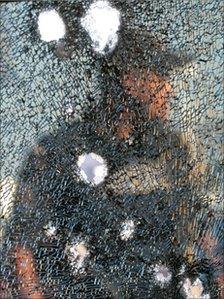Crunching numbers in Mexico's drug conflict
- Published

Nearly 35,000 people have been killed in drug-related violence since late 2006
The launch this week of a comprehensive official database of drug-related killings around Mexico provides a new insight into the complexity of the conflict with criminal groups that traffic drugs into the United States.
Until now, the public relied mostly on tallies elaborated by national media outlets or on sporadic - and sometimes confusing - figures released by different government institutions.
Many in Mexico have therefore welcomed the publication of a unified set of data that for the first time includes not only fallen gang members, but also police, soldiers and innocent civilians killed in the fight against the cartels.
However, that positive development has been overshadowed by the grim scenario that the figures depict - and some complain that they only show one, even if the most tragic, aspect of the conflict.
According to the database, external, the total number of people killed in the conflict between December 2006, when President Felipe Calderon came into power, and the end of 2010, stands at 34,612.
Last year was by far the bloodiest since Mr Calderon launched his head-on military confrontation with the cartels, with 15,273 deaths.
'Transparency'
President Calderon said the database would "strengthen transparency and accountability".
"In the federal government, we are aware of the need for this struggle [against organised crime] to be carried out with openness towards society," he added.
At least 89% of the fatalities are suspected gang members killed in turf wars between the different organisations that compete for control of trafficking routes into the US.
The government argues that this shows the cartels are feeling the heat of the government's crackdown. But critics say it demonstrates that Mr Calderon's strategy, instead of controlling the violence, has actually fuelled it.
Mexican officials have repeatedly said that the overall per capita murder rate in Mexico (including those not related to the drugs conflict) is lower than rates in other Latin American countries like Brazil, Colombia and Venezuela.
Ravaged
But the newly-released statistics paint a complex security scenario in some parts of Mexico.
Take, for instance, the northern state of Chihuahua, on the border with the US.

Officials point out that violence is confined to specific areas
In 2007, there were 244 drug-related deaths. The same figure for 2010 was of 4,427 victims - it grew by an astonishing 1,800%.
The state is home to Ciudad Juarez - the city across the border from El Paso, Texas - where 6,437 people have lost their lives in drug-related violence since late 2006.
That one city of less than 1.5 million people was the location for more than 18% of the total number of deaths nationwide in the same period.
Other badly affected regions were Tamaulipas, in the north-east of the country and also close to the border with the US, and Sinaloa, on the Pacific Coast and home to Mexico's most wanted drug baron, Joaquin "El Chapo" Guzman.
Meanwhile, in states like Tlaxcala, only 13 people have been killed in the conflict since 2006; in Yucatan, the total figure is 26.
This is a point that the Mexican government seems keen to highlight - the violence is confined to very specific areas and other regions are almost completely spared from the killings.
In fact, 70% of the homicides, the database shows, have taken place in only 85 of the 2,500 municipalities around Mexico.
Visibility
The rising number of deaths related to the drugs conflict is accompanied by some high-profile murders that, according to experts, have contributed to the visibility of the violence.
At least 12 mayors were killed by alleged gang members in 2010, while in the first two weeks of 2011, two more died in incidents related to the drugs conflict.

The government says it is making progress in the fight against organised crime
The killing of at least nine local journalists at the hands of criminal groups last year also made Mexico one of the most dangerous countries in the world to be a reporter.
The government, on the other hand, has statistics at hand that show the inroads it has made in the battle against organized crime.
From a list of 37 "wanted" drug barons issued by the government in March 2009, 17 were captured or killed by government forces - including Arturo Beltran Leyva, head of the Beltran Leyva cartel, in December 2009 - while two were killed in clashes between criminal groups.
Security forces have confiscated almost 100,000 weapons from the cartels, while the value of the seized narcotics amounts to more than $10bn (£6.3bn).
The authorities say they are purging corrupt local police forces and they are also hitting the cartels where it hurts them most: their finances.
Future
Government security spokesman Alejandro Poire points out that the number of drug-related murders decreased by about 10% in the last quarter of 2010, and officials hope this will become a long-term trend.
But as the country gears up for a presidential election next year, the drugs conflict seems set to dominate the political agenda.

Many Mexicans now seem used to living in fear
The daily news of beheadings, executions and mass killings by criminal groups seems to have taken a toll on Mexicans' perception of security.
In a recent nationwide survey by the National Statistics Bureau, more than 70% of respondents said they felt the overall security situation had worsened in 2010 compared to the previous year. More than 30% believed the situation would get worse in 2011.
Meanwhile, 41% admitted they did not feel safe to walk alone between 4pm and 7pm in the area where they lived.
That is what some in Mexico think is the most worrying aspect of the conflict - the fact that many citizens now seem used to living in fear.
- Published13 January 2011